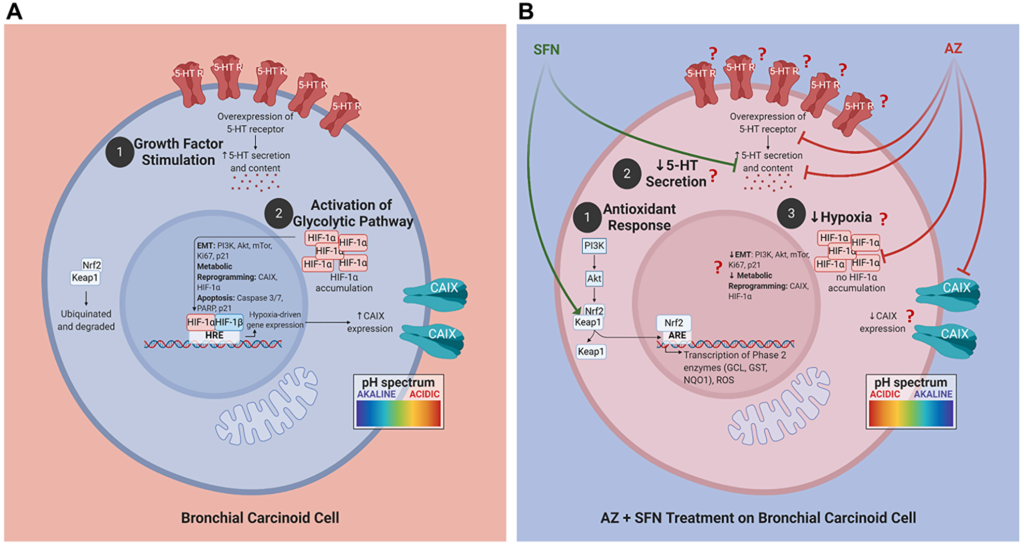The mechanism(s) by which a nutrigenetic compound exerts its therapeutic effect on bronchial carcinoid cancer in vitro and in vivo was investigated in this study.

The Trending With Impact series highlights Oncotarget publications attracting higher visibility among readers around the world online, in the news, and on social media—beyond normal readership levels. Look for future science news about the latest trending publications here, and at Oncotarget.com.
—
Nutrigenomics is the scientific study of the relationship between nutrition, health and the human genome. Nutritional benefits from dark, leafy greens are not merely limited to eliminating free radicals and reducing inflammation—they may also protect our DNA and slow tumor growth. Research reveals that sulforaphane (SFN), a chemical compound found in cruciferous vegetables (such as broccoli, brussels sprouts and cabbage), is capable of activating the expression of several cellular protective genes.
“The phytochemical and bioactive agent sulforaphane (SFN) has nutrigenomic potential in activating the expression of several cellular protective genes via the transcription factor nuclear factor erythroid 2-related factor 2 (Nrf2).”
Researchers have previously evaluated the nutrigenomic potential of this compound in combination with a carbonic anhydrase inhibitor drug, acetazolamide (AZ), to treat cancers, including bladder cancer and lung bronchial carcinoids (BCs). BCs are rare, well-differentiated and malignant neuroendocrine tumors (NETs). When combined, these compounds were found to significantly inhibit the viability, clonogenicity and in vitro growth of two BC cell lines.
In a new study, researchers—from The Hospital for Sick Children, University of Massachusetts, Queen’s University, IRCCS Casa Sollievo della Sofferenza, University of Chicago, Q.P.S. Holdings LLC, University of Toronto, Indian Institute of Technology Guwahati, and the Forsyth Institute—investigated the mechanisms modulated by SFN, AZ and by SFN and AZ combined, using in vitro and in vivo models of BC cell lines. Their paper was published by Oncotarget in 2021 and entitled, “Next-generation multimodality of nutrigenomic cancer therapy: sulforaphane in combination with acetazolamide actively target bronchial carcinoid cancer in disabling the PI3K/Akt/mTOR survival pathway and inducing apoptosis.”
The Study
“In this study, we investigated the mechanism(s) by which SFN combined with AZ exerts its nutrigenetic therapeutic effect on BC cell lines and in BC xenograft tissues derived from H727 and H720 BC cells previously developed in NOD/SCID mice.”
To determine the exact mechanisms of action of SFN and AZ in typical H727 (BC) xenografts and atypical H720 (BC) cell lines, the team employed a number of methods and materials to observe cell viability, morphologic changes, apoptosis activity and the expression levels of phospho-Akt1, Akt1, HIF-1α, PI3K, p21, CAIX, 5-HT, phospho-mTOR, and mTOR. Methods and materials included: microscopic imaging, immunocytochemistry, wound healing assay, caspase-cleaved cytokeratin 18 (M30, CCK18) CytoDeath ELISA assay, immunofluorescence labeling assays (for apoptosis and hypoxia), Western Blotting, Tunnel assay, measurement of 5-HT secretion by carbon fiber amperometry assay, and quantitative methylation-specific PCR (qMSP).
“For the first time, these findings as depicted in Figure 9 demonstrate that SFN in combination with AZ provides a practical nutrigenetic therapeutic approach in targeting multistage pro-survival pathways in bronchial carcinoids.”

“The combination of SFN and AZ reduced migration of BC in a scratch wound, upended pro-survival hypoxia-mediated pathways resulting in decreased 5-HT secretion, upended the pro-survival PI3K/Akt/mTOR pathway of BC xenografts of H727 and H720 cells, targeted the pro-survival Keap1/Nrf2 pathway, and induced bronchial carcinoid cell apoptosis.”
Conclusion
“The PI3K/Akt/mTOR pathway is a primary target of the SFN+AZ combination therapy [43, 44].”
In sum, the paper reveals that SFN alone effectively targeted the PI3K/Akt/mTOR pathway—an important axis responsible for a number of cellular processes, including cell survival, proliferation, growth, metabolism, angiogenesis, and metastasis—and induced the expression of p21. When SFN was combined with AZ, the pair markedly targeted the PI3K/Akt/mTOR pathway’s inhibitory effect.
“Although SFN is responsible for a significant proportion of the inhibitory effect, AZ’s addition potentiated this inhibitory effect.”
Click here to read the full research paper, published by Oncotarget.
YOU MAY ALSO LIKE: More Oncotarget Videos on LabTube
—
Oncotarget is an open-access journal that publishes primarily oncology-focused research papers in a continuous publishing format. These papers are available at no cost to readers on Oncotarget.com. Open-access journals have the power to benefit humanity from the inside out by rapidly disseminating information that may be freely shared with researchers, colleagues, family, and friends around the world.
For media inquiries, please contact media@impactjournals.com.



